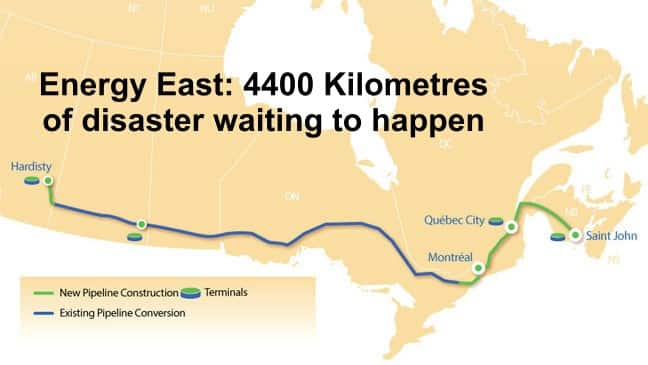
TransCanada’s plan to pipe over a million 1.1 million barrels pipe tar sands bitumen — every day! — from Alberta to Canada’s east coast threatens 4,400 hundred kilometres of rivers, lakes, forests, farmlands and communities with environmental disasters.
Its plan to ship that poisonous brew in giant tankers to refineries in Europe and Asia threatens the world’s oceans, and, if approved, will lock in even more greenhouse gas emissions and climate change.
This project makes Keystone XL look small.
But the movement against Energy East is growing. Activists in Northern Ontario have created an excellent website, packed with information that activists across the country can and should use to build public opinion against this latest effort to profit from the world’s worst environmental crime, the Alberta tar sands.
Bookmark this site: Say NO to TransCanada’s ‘Energy East’ TarSands Pipeline
And download this: Energy East fact sheet, prepared by the Council of Canadians
—–
Ian



Using the politically-neutral, non-pejorative, and technically- and scientifically-correct terms “bitumen” and “bitumen sands” will go a long way to making your points to the people who can actually do something to improve things.
They are not tar sands and they are not oil sands but a bituminous sandstone (or carbonate)- bitumen sands if you please.
One could make the analogy that syncrude is to bitumen as synthetic motor oil is to conventional crude. Syncrude is made from bitumen, not tar sands as there is no such thing, and it is no longer bitumen but rather the equivalent of a sweet, conventional crude feedstock for refineries and petrochemical plants that is high value and can be easily pumped.
The NEB must mandate that the primary raison d’etre for the Energy East pipeline is to displace all imports of foreign crude.
The second use for the crude shipped must be Canadian petro-chemical feedsstock.
There will be some excess volumes exported and I and others are working at getting all raw bitumen/dilbit production at least partially upgraded to make it pumpable without the use of diluents for shipping as dilbit which I believe is an economic and environmental abomination.
I am uncomfortable with Saint John NB as the main export point for marine shipping on Canada’s East Coast because of its location on the Bay of Fundy.
Would much rather see the line extended three hundred miles further east and use the safer Canso Superport as the main export point.
Bitumen carbonate? Do you refer to water as di-hydrogen oxide?
Tar Sand is the term everyone, including the oil companies, used for decades. That’s because “tar” and “bitumen” are synonyms — check any good dictionary. We make no apologies for using the word people understand.
The Alberta government started saying “oil sand” in the 1960s, as a public relations maneuver similar to changing Kentucky Fried Chicken to KFC. But Colonel Sanders still sells parts of factory-farmed birds, drenched in fat — and the stuff they’re mining in Alberta is still a very dirty source of oil and a major contributor to climate change.
Poisonous brew? Is that the stuff you use to power your vehicle, lawn mower and the jets to Macchu Picu and Kathmandu? And the trucks and trains to provide you with food and consumer electronics? And maintain the urban environments that people like you could not survive without?
TransCanada CEO Girling has repeatedly stated that, initially, only light, conventional, medium-heavy, and syncrude will be transported by Energy East because only the Irving refinery can handle any significant volume of dilbit – which I agree is an unacceptable product for Alberta to produce and export.
Instead of writing poisonous and erroneous diatribes, why not direct your energy to eliminating the production and export of dilbit by encouraging at least partial upgrading of raw bitumen and improving the environmental performance of bitumen extraction, processing and transport?
Mike, as you say, initially Energy East will carry lighter products, including “syncrude,” which (as you don’t say) is a tar sands product. That’s because most east coast refineries can’t handle the heavier stuff. But a central part of the project is a deep sea port, designed for supertankers, to carry dilbit to refineries that can handle it, in India and Spain. Otherwise, the pipeline would be mostly empty, because Alberta can’t produce 1.1 million barrels a day of the light stuff for very long.
Why don’t we concentrate on improving the environmental performance of the tar sands? Because, as management guru Peter Drucker once said, there is nothing less efficient that doing something very well that shouldn’t be done at all.
12 billion dollars invested in fossil fuel infrastructure simply locks in technology we ought to be phasing out, and guarantees that the tar sands projects will continue to destroy forests, poison rivers, and displace indigenous people. The same amount invested in renewables could actually help save the earth.